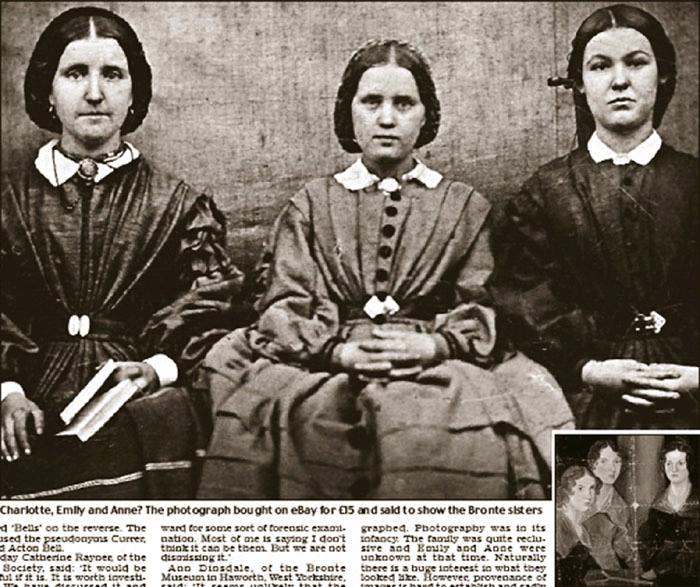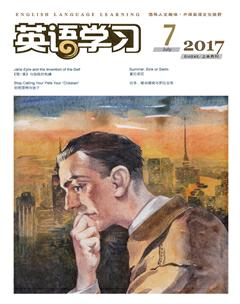《简·爱》与自我的构建
By+Karen+Swallow+Prior
Consider the selfie. By now, its a fairly mundane artistic tradition, even after a profusion of thinkpieces have wrestled with its rise thanks to the so-called Me Generations “obsession” with social media.1 Anyone in possession of a cheap camera phone or laptop can take a picture of themselves, edit it(or not), and share it with the world in a matter of seconds.
But before the selfie came “the self,” or the fairly modern concept of the independent“individual.” The now-ubiquitous selfie expresses in miniature the seismic2 conceptual shift that came about centuries ago, spurred in part by advances in printing technology and new ways of thinking in philosophy. Its not that the self didnt exist in pre-modern cultures: Rather, the emphasis the Protestant Reformation3 in the 16th century placed on personal will, conscience, and understanding—rather than tradition and authority—in matters of faith spilled over the bounds of religious experience into all of life. Perhaps the first novel to best express the modern idea of the self was Jane Eyre, written in 1847 by Charlotte Bront?.4
Those who remember Jane Eyre solely as required reading in high-school English class likely recall most vividly its overthe-top Gothic tropes: a childhood banishment to a deathhaunted room, a mysterious presence in the attic, a Byronic hero,5 and a cold mansion going up in flames. Its more seemingly the stuff of Lifetime6 television, not revolutions. But as unbelievable as many of the events of the novel are, even today, Bront?s biggest accomplishment wasnt in plot devices. It was the narrative voice of Jane—who so openly expressed her desire for identity, definition, meaning, and agency7—that rang powerfully true to its 19th-century audience. In fact, many early readers mistakenly believed Jane Eyre was a true account (in a clever marketing scheme, the novel was subtitled, “An Autobiography”), perhaps a validation of her characters authenticity.
The way that novels paid attention to the particularities of human experience (rather than the universals of the older epics and romances8) made them the ideal vehicle to shape how readers understood the modern individual. The rise of the literary form was made possible by the technology of the printing press, the print culture that followed, and the widening literacy that was cultivated for centuries until Jane Eyres publication. The novel seemed perfectly designed to tell Bront?s first-person narrative of a destitute orphan girl searching for a secure identity—first among an unloving family, then an austere charity school,9 and finally with the wealthy but unattainable employer she loves. Unable to find her sense of self through others, Jane makes the surprising decision to turn inward.
The broader cultural implications of the story—its insistence on the value of conscience and will—were such that one critic fretted some years after its publication that the “most alarming revolution of modern times has followed the invasion of Jane Eyre.” Before the Reformation and the Enlightenment that followed, before Rene Descartess cogito ergo sum (“I think, therefore I am”),10 when the sources of authority were external and objective, the aspects of the self so central to todays understanding mattered little because they didnt really affect the course of an individuals life. The Reformation empowered believers to read and interpret the scriptures for themselves, rather than relying on the help of clergy; by extension, this seemed to give people permission to read and interpret their own interior world.
To be sure, early novelists before Bront? such as Frances Burney, Daniel Defoe, Samuel Richardson, and Mary Shelley contributed to the forms developing art of the firstperson narrator.11 But these authors used the contrivances of edited letters or memoirs, devices that tended toward underdeveloped characters, episodic plots,12 and a general sense of artificiality—even when the stories were presented not as fiction but “histories.” No earlier novelist had provided a voice so seemingly pure, so fully belonging to the character, as Bront?. She developed her art alongside her sisters, the novelists Anne and Emily (all of them publishing under gender-neutral pseudonyms),13 but it was Charlotte whose work best captured the sense of the modern individual. Anne Bront?s novels Agnes Grey and The Tenant of Wildfell Hall contributed to the novels ability to offer social commentary and criticism, while the Romantic sensibilities of Emily Bront?s Wuthering Heights explored how the “other,” in the form of the dark, unpredictable Heathcliff, can threaten the integrity of the self.
One of the greatest testimonies to Bront?s accomplishment came from Virginia Woolf,14 a modernist pioneer who represents a world far removed from that of Bront?s Victorianism. “As we open Jane Eyre once more,” a doubting Woolf wrote in The Common Reader, “we cannot stifle the suspicion that we shall find her world of imagination as antiquated, mid-Victorian, and out of date as the parsonage on the moor, a place only to be visited by the curious, only preserved by the pious.”15 Woolf continues, “So we open Jane Eyre; and in two pages every doubt is swept clean from our minds.” There is nothing of the book, Woolf declares, “except Jane Eyre.” Janes voice is the source of the power the book has to absorb the reader completely into her world. Woolf explains how Bront? depicts:
… an overpowering personality, so that, as we say in real life, they have only to open the door to make themselves felt. There is in them some untamed ferocity perpetually at war with the accepted order of things which makes them desire to create instantly rather than to observe patiently.16
It is exactly this willingness—desire, even—to be “at war with the accepted order of things” that characterizes the modern self. While we now take such a sense for granted, it was, as Bront?s contemporaries rightly understood, radical in her day. More disturbing to Bront?s Victorian readers than the sheer sensuality of the story and Janes deep passion was “the heroines refusal to submit to her social destiny,”as the literary critic Sandra M. Gilbert explains. Indeed, one contemporary review complained, “It is true Jane does right, and exerts great moral strength,” but the critic continues that“it is the strength of a mere heathen17 mind which is a law unto itself.” In presenting such a character, the reviewer worries,Bront? has “overthrown authority” and cultivated “rebellion.”And in a way they were right: “I resisted all the way,” Jane says as she is dragged by her cruel aunt toward banishment in the bedroom where her late18 uncle died. This sentence, Joyce Carol Oates argues, serves as the theme of Janes whole story.
But Janes resistance is not the empty rebellion of nihilism or self-absorption (consider how current practitioners of “selfie culture” frequently weather accusations of narcissism).19 Rather, her quest for her true self peels back the stiff layers of conventionality in order to discover genuine morality and faith. As Bront? explains in the preface to the novels second edition (a preface necessitated by the moral outrage that followed the novels publication),
Conventionality is not morality. Self-righteousness is not religion. To attack the first is not to assail the last…These things and deeds are diametrically20 opposed: they are as distinct as is vice from virtue. Men too often confound them: they should not be confounded: appearance should not be mistaken for truth; narrow human doctrines, that only tend to elate and magnify a few,21 should not be substituted for the world.
In a letter to a friend, Bront? responded to her criticsobjections by declaring, “Unless I have the courage to use the language of Truth in preference to the jargon22 of Conventionality, I ought to be silent...”
The refusal of such a woman, who lived in such a time, to be silent created a new mold for the self—one apparent not only in todays Instagram photos, but also more importantly in the collective modern sense that a persons inner life can allow her to effect change from the inside out.
想想自拍吧。现在,自拍成了一种再寻常不过的艺术传统,甚至是在铺天盖地的批评文章全力开火之后,自拍之风仍然因所谓的唯我的一代“病态地迷恋”社交媒体而蔓延开来。任何人只要有一部价格低廉、具备照相功能的手机或者笔记本电脑就能自拍、修图(或者不修图),然后与世界分享之:整个过程只需要几秒钟的时间。
但自拍出现之前先有“自我”,或者说独立“个体”这一非常现代的观念。如今无处不在的自拍以小见大地表达了几个世纪之前所发生的巨大的观念转变,这一转变一定程度上是由印刷技术与哲学新思想促成的。这并不是说自我在前现代文化中就不存在:相反,16世纪宗教改革在信仰方面对于个人意志、良知与理解——而非传统与权威——的强调从宗教生活的界限外溢到生活的方方面面。或许第一部最能表达“自我”这一现代观念的小说就是夏洛蒂·勃朗特于1847年写就的《简·爱》了。
那些仅仅将《简·爱》作为高中英语课必读书目印刻在记忆中的人很可能会想起作品中夸张的哥特式表达手法:童年被关进被死亡阴影笼罩着的房间、阁楼中神秘的存在、一位拜伦式的英雄以及在腾腾烈焰中焚毁的冷冰冰的宅子。这看上去更像是Lifetime电视台才会播出的情节,而非思想变革。尽管这本小说中的许多情节不足为信,甚至放到今天依然如此,但是勃朗特最高的成就并非在于情节构想,而是在于简的叙述——她公开地表达了自己对于身份、定义、意义以及施为能力的渴望——让19世纪的读者产生了强烈的真实感。事实上,许多早期的读者误把《简·爱》当做一部真實的记录(出于高明的营销手段,这部小说的副标题为“一部自传”),或许这证明了作品人物的真实性。
由于小说关注人类经历的特性(而不像早期史诗与罗曼司关注共性),因此小说成为理想的载体来使读者形成对现代个体的理解。小说这种文学形式之所以能够兴起,原因在于印刷技术的革新、随之而来的出版文化以及《简·爱》出版前几个世纪以来广大民众识字水平的不断提高。这部小说似乎完美地呈现了勃朗特以第一人称叙述的一位贫穷的孤女对某种稳定身份的追寻——首先是在一个缺乏关爱的家庭,然后是在一个环境严苛的慈善学校,最后是在她富裕却爱而不得的雇主身上。因无法从他人身上找到自我的意义,简出乎意料地决定转向内心。
这个故事——坚持良知与意志的价值——的文化影响如此广泛,以至于某位批评家在该书出版数年之后愤愤道:“当今最令人惊恐的革命就是从《简·爱》的入侵开始的。”在随后的宗教改革与启蒙运动之前,在勒内·笛卡尔的“我思故我在”之前,在权威的建立还是来源于外在、客观的时候,现今人们意识中如此核心的“自我”概念在那时是无足轻重的,因为“自我”在当时并不会真正影响个体的生命轨迹。宗教改革赋予信徒自行阅读、解读《圣经》的权力,而无需依靠神职人员的帮助;进一步说,这似乎给了人们阅读、解读自己内心世界的许可。
可以肯定的是,勃朗特之前的早期小说家,比如弗朗西斯·伯尼、丹尼尔·笛福、塞缪尔·理查逊和玛丽·雪莱,均为小说发展中的第一人称叙事艺术作出了贡献。但这些作者故意使用一些类似编辑过的信件或者回忆录之类的写作手法。这些手法往往造成角色塑造不够丰满、情节比较松散,而且总体上给人一种生编硬造的感觉——哪怕这些故事并非作为虚构作品而是“历史”呈现时也一样。没有一位早期的小说家像勃朗特那样发出一个听起来如此纯粹的声音,一个完完全全属于某个角色的声音。她与同为小说家的姐妹安妮和艾米莉一同(她们全部都使用中性的化名发表作品)推进小说艺术,但夏洛蒂的作品最好地捕捉到了现代个体的意识。安妮·勃朗特的小说《艾格妮丝·格雷》和《怀尔德菲尔府的房客》为小说进行社会评论与批评的能力作出了贡献,而艾米莉·勃朗特在《呼啸山庄》中表现出的浪漫情感则探讨了以阴郁黑暗、反复无常的希斯克利夫为化身的“他者”如何能够威胁到“自我”的完整。
对于勃朗特的成就,最大的肯定之一来自弗吉尼亚·伍尔芙,这位现代主义的先锋代表着与勃朗特的维多利亚式的世界截然不同的世界。“再次翻开《简·爱》,”持怀疑态度的伍尔芙在《普通读者》中写道,“我们无法不去怀疑自己会发现她的想象世界像荒原上的教区牧师寓所一般老旧、充满维多利亚中期的色彩而且过时,只有好奇的人才会造访,只有虔诚的人才会保存。”伍尔芙接着写道,“因此我们翻开《简·爱》;翻了两页,所有的疑虑都从脑海里打消了。”书里什么也没有,伍尔芙宣称,“除了简·爱。”简的声音就是这本书的力量源泉,让读者完全沉浸在她的世界里。伍尔芙解释了勃朗特是如何刻画的:
……一种压倒性的强烈个性,以至于像我们现实生活中所说的,他们只需要打开门就能让人们感觉到他们。他们带有某种未被驯服的野性,永远与公认的秩序抗争,这让他们渴望立刻地创造而不是耐心地遵守。
正是这种“与公认的秩序抗争”的意愿——甚至,渴望——构成了现代自我的特点。虽然我们如今把这种意识视为理所当然,可是正如勃朗特同时代的人们所认为的那样,这在她的时代是激进的。相比故事纯粹的感性与简的激情,对于维多利亚时期的勃朗特读者而言更令人不安的是“女主角拒绝屈服于自身的社会命运,”文学批评家桑德拉·M.吉尔伯特解释道。确实,一篇当时的评论抱怨称“无可否认简做得没错而且散发出了巨大的道德力量,”但这位批评家继续写道,“这股力量来自区区一个不信教的头脑,而且这个头脑自己为自己制定法则。”通过呈现这样一个角色,这位评论家担心,勃朗特已经“颠覆了权威”并且培养了“反叛精神”。从某种意义上说,他们是对的:“我一路反抗,”简在被她冷酷的舅母拖进舅舅去世时所在的房间时说出了这样一句话。乔伊斯·卡洛尔·欧茨认为这一句点出了简·爱整个故事的主题。
但简的抗争并非是虚无主义那种空洞的反叛或是出于自恋的原因(想想时下“自拍文化”的实践者是如何经受常常被指责自恋的)。相反,她对真正自我的追求把僵硬的习俗的禁锢一层层剥下,为的是发现真正的道德与信仰。正如勃朗特在小说第二版序言(这篇序言就是为了回应小说出版后引发的道德愤慨)中解释的那样:
习俗并不是道德。自以为是也不是宗教。抨击前者并不等于抨击后者……这些事情与行为是完全对立的:就像善恶一样分明。人们总是弄混,而它们不应被弄混:表象不应被误认为是真理;狭隘的人类教条,如果只会让少数人得意洋洋、高高在上,就不应被当作普世原则。
在一封写给朋友的信中,针对她的批评者所发出的反对声音,勃朗特回应道,“除非我有勇气使用真理的语言而不是习俗的套话,否则我应该沉默……”
生活在这样一个时代的这样一名女性拒绝沉默,为“自我”创造了一个新的典范——这样一种自我不仅明显存在于当下的Instagram照片中,而且更重要的是明显存在于集体的现代意识中,这种意识认为一个人的内心生活可以让她由内而外地发生改变。
1. mundane: 普通的,平凡的;a profusion of: 丰富的,大量的;thinkpiece: 时事短评,内幕新闻报道。
2. seismic: 巨大而急剧的。
3. Protestant Reformation: 宗教改革,指16世纪至17世纪西方基督教自上而下的教派分裂及改革运动,是新教形成的开端。
4. Charlotte Bront?: 夏洛蒂·勃朗特(1816—1855),英国女作家,世界名著《简·爱》的作者,生于英国北部约克郡豪渥斯的一个乡村牧师家庭,她与两个妹妹(艾米莉·勃朗特和安妮·勃朗特)在英国文学史上有“勃朗特三姐妹”之称。
5. Gothic:(文学风格)哥特派的,指以恐怖、超自然、死亡、古堡、黑夜、吸血鬼等为标志性元素的文学体裁;trope: 比喻,转义;banishment:放逐,驱逐;Byronic hero:“拜伦式英雄”,指19世纪英国浪漫主义诗人拜伦作品中的一类人物形象。他们高傲倔强,既不满现实,要求奋起反抗,同时又显得忧郁、孤独,始终找不到正确的出路。
6. Lifetime: 是美国领先的女性有线电视频道,该台主要出品电影、情景剧和连续剧。
7. agency: 能动作用,指個体基于自身意愿独立行动、作出自由选择的能力。
8. romance: 欧洲封建社会里流行的一种传奇文学,最有名的是中世纪的骑士系列,后指长篇英雄故事。
9. destitute: 赤贫的,一无所有的;austere:(人)严厉的,(生活)清苦的。此处结合《简·爱》的情节,应取两者结合之意。
10. Enlightenment: 启蒙运动,是发生在17-18世纪欧洲的一场反封建、反教会的思想文化解放运动,它为欧洲资产阶级革命做了思想准备和舆论宣传;Rene Descartes: 勒内·笛卡尔(1596—1650),法国著名哲学家、数学家、物理学家,被认为是解析几何之父和西方现代哲学思想的奠基人。
11. Frances Burney: 弗朗西斯·伯尼(1752—1840),英国女小说家,代表作为小说《伊芙琳娜》;Daniel Defoe: 丹尼尔·笛福(1660—1731),英国作家,英国启蒙时期现实主义小说的奠基人,代表作为《鲁滨逊漂流记》;Samuel Richardson: 塞缪尔·理查逊(1689—1761),英国著名小说家、保守派作家,代表作有《克拉丽莎》、《帕米拉》等,作品多关注婚姻道德问题;Mary Shelley: 玛丽·雪莱(1797—1851),英国小说家,诗人雪莱的继室,因1818年创作了文学史上第一部科幻小说《弗兰肯斯坦》而被誉为科幻小说之母。
12. contrivance: 人为的修饰,构思;episodic: 有许多片断的。
13. gender-neutral: 中性的,因当时女性作家遭到歧视,故勃朗特姐妹使用看不出性别的化名,比如夏洛蒂·勃朗特化名为柯勒·贝尔;pseudonym: 假名,笔名。
14. testimony: 证据,证明;Virginia Woolf:弗吉尼亚·伍尔芙(1882—1941),英国女作家,意识流文学代表人物,被誉为20世纪现代主义与女性主义的先锋,代表作有《达洛维夫人》、《到灯塔去》等。
15. stifle: 压抑,控制;antiquated: 老旧的;parsonage: 教区牧师寓所;moor:荒野。
16. untamed: 未经驯服的,野性的;ferocity: 凶猛,残暴。
17. heathen: 不信教的。
18. late: 已故的,新近去世的。
19. nihilism: 虚无主义,即认为一切没有意义,否定真理的存在;weather: v. 经受住,克服。
20. diametrically: 截然相反地。
21. elate: 使高兴,使得意;magnify: 推崇,吹捧。
22. jargon: 术语,行话。

